Analysing Business Environment, Organisations, and Functions Report
VerifiedAdded on 2021/02/20
|9
|2392
|52
Report
AI Summary
This report provides a comprehensive analysis of the business environment, focusing on different organizational types, their purposes, legal structures, and stakeholders. It examines public, private, and voluntary organizations, using Kings Place as a case study for private sector analysis. The report delves into the size and scope of these organizations and explores the interrelationships among organizational functions such as marketing, human resources, and finance. It highlights the importance of organizational structures, like the divisional structure implemented by Kings Place, and their impact on business operations. The report concludes by emphasizing the interconnectedness of various business functions and their contribution to achieving organizational objectives. The analysis includes references to relevant literature, providing a well-rounded understanding of the subject matter.
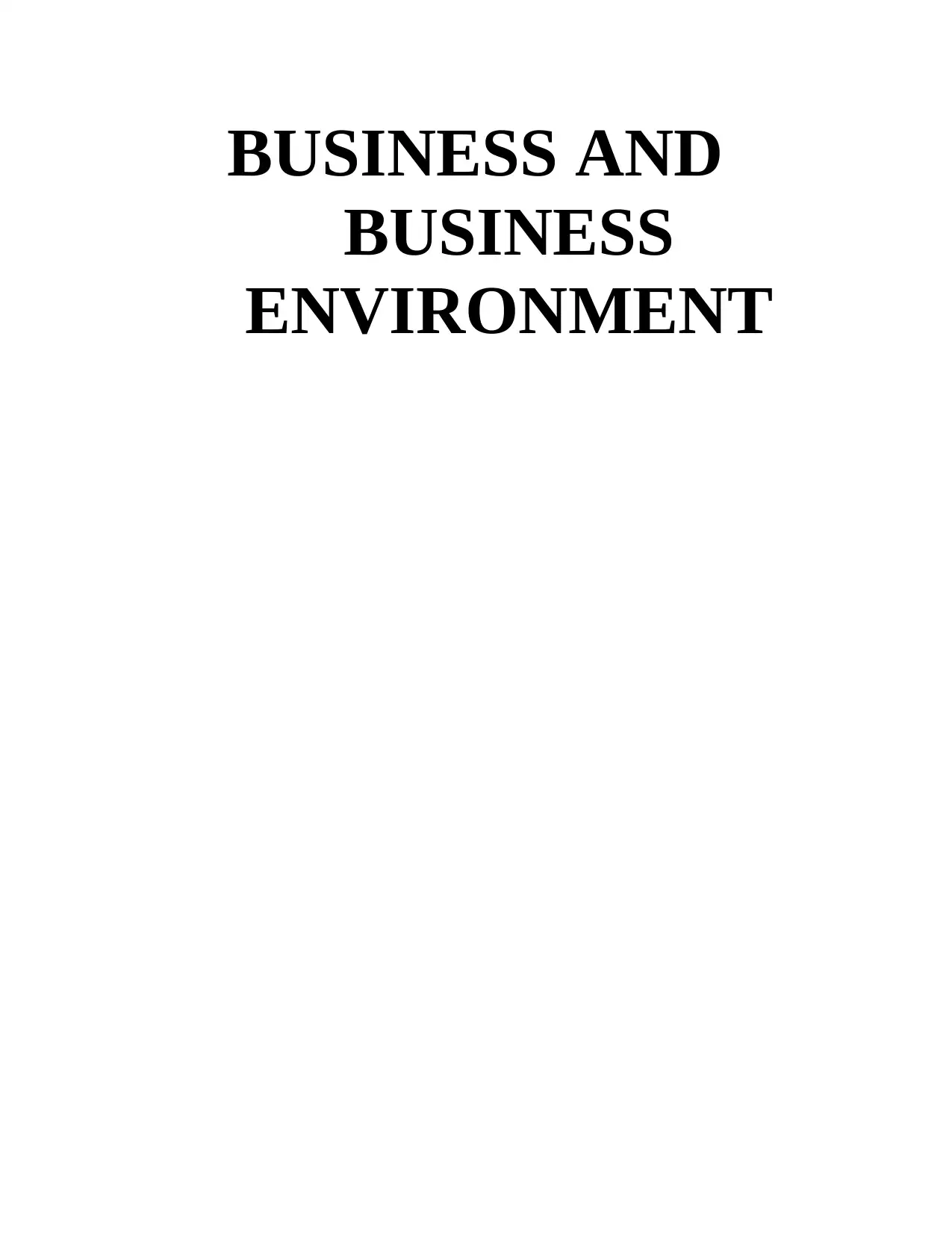
BUSINESS AND
BUSINESS
ENVIRONMENT
BUSINESS
ENVIRONMENT
Paraphrase This Document
Need a fresh take? Get an instant paraphrase of this document with our AI Paraphraser
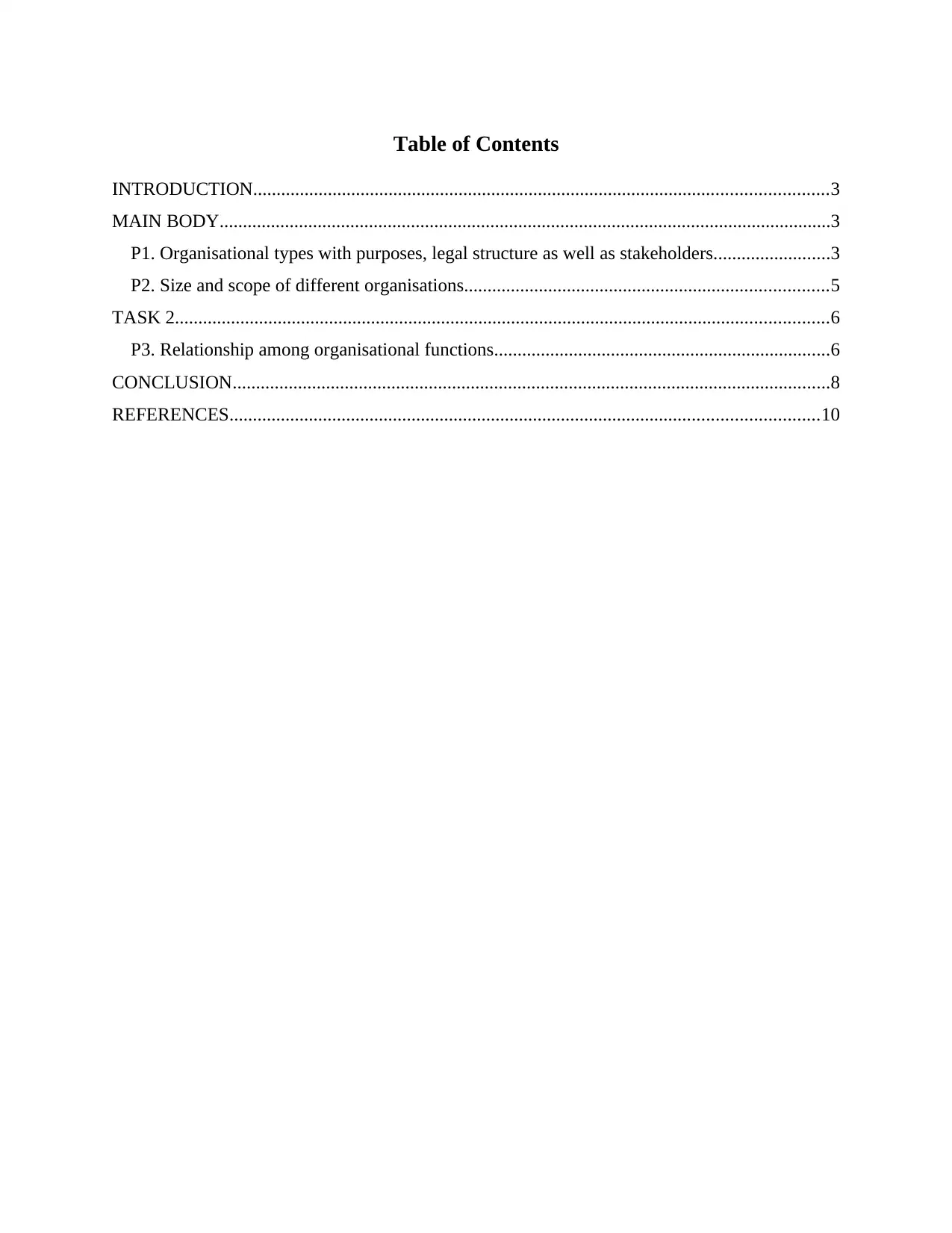
Table of Contents
INTRODUCTION...........................................................................................................................3
MAIN BODY...................................................................................................................................3
P1. Organisational types with purposes, legal structure as well as stakeholders.........................3
P2. Size and scope of different organisations..............................................................................5
TASK 2............................................................................................................................................6
P3. Relationship among organisational functions........................................................................6
CONCLUSION................................................................................................................................8
REFERENCES..............................................................................................................................10
INTRODUCTION...........................................................................................................................3
MAIN BODY...................................................................................................................................3
P1. Organisational types with purposes, legal structure as well as stakeholders.........................3
P2. Size and scope of different organisations..............................................................................5
TASK 2............................................................................................................................................6
P3. Relationship among organisational functions........................................................................6
CONCLUSION................................................................................................................................8
REFERENCES..............................................................................................................................10
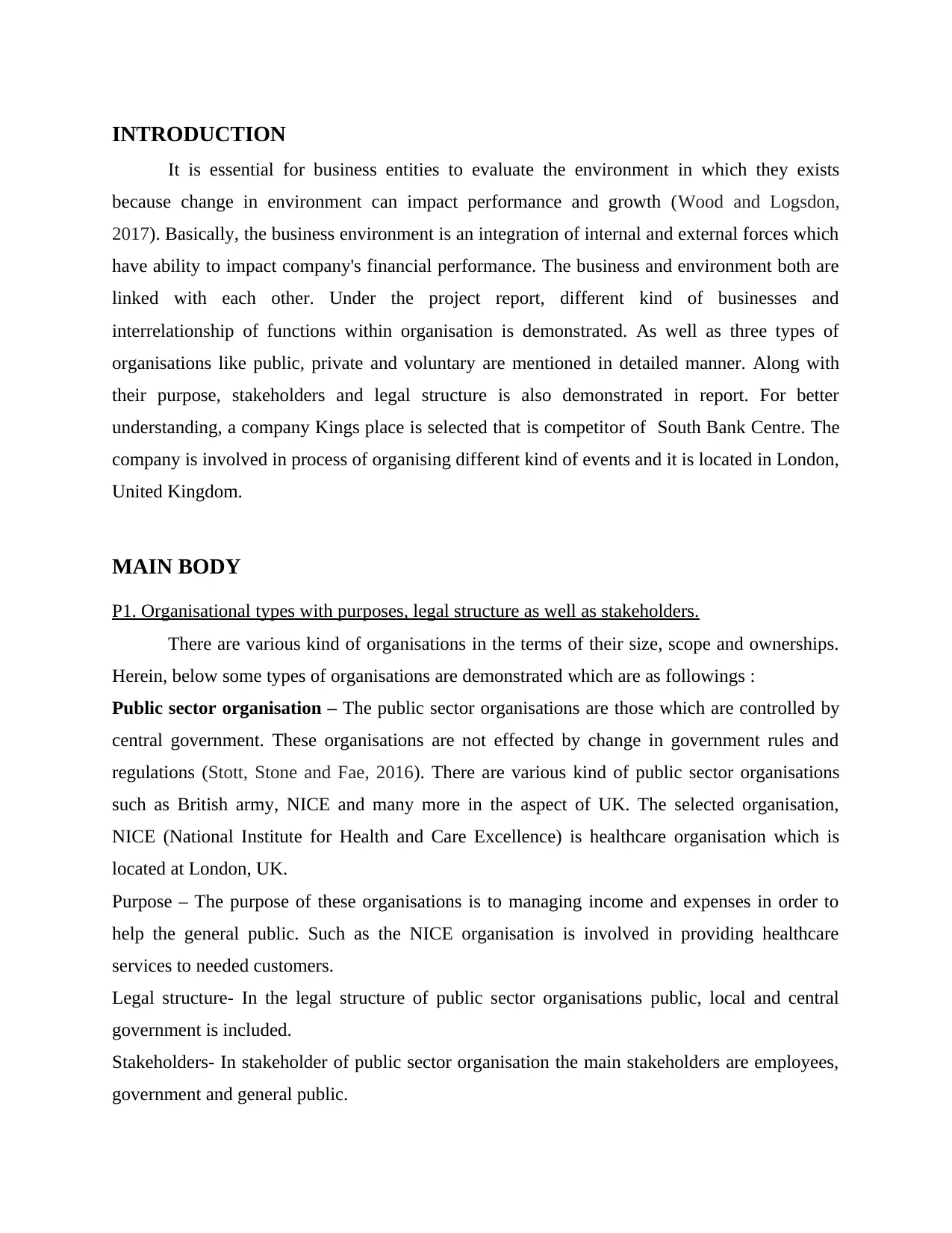
INTRODUCTION
It is essential for business entities to evaluate the environment in which they exists
because change in environment can impact performance and growth (Wood and Logsdon,
2017). Basically, the business environment is an integration of internal and external forces which
have ability to impact company's financial performance. The business and environment both are
linked with each other. Under the project report, different kind of businesses and
interrelationship of functions within organisation is demonstrated. As well as three types of
organisations like public, private and voluntary are mentioned in detailed manner. Along with
their purpose, stakeholders and legal structure is also demonstrated in report. For better
understanding, a company Kings place is selected that is competitor of South Bank Centre. The
company is involved in process of organising different kind of events and it is located in London,
United Kingdom.
MAIN BODY
P1. Organisational types with purposes, legal structure as well as stakeholders.
There are various kind of organisations in the terms of their size, scope and ownerships.
Herein, below some types of organisations are demonstrated which are as followings :
Public sector organisation – The public sector organisations are those which are controlled by
central government. These organisations are not effected by change in government rules and
regulations (Stott, Stone and Fae, 2016). There are various kind of public sector organisations
such as British army, NICE and many more in the aspect of UK. The selected organisation,
NICE (National Institute for Health and Care Excellence) is healthcare organisation which is
located at London, UK.
Purpose – The purpose of these organisations is to managing income and expenses in order to
help the general public. Such as the NICE organisation is involved in providing healthcare
services to needed customers.
Legal structure- In the legal structure of public sector organisations public, local and central
government is included.
Stakeholders- In stakeholder of public sector organisation the main stakeholders are employees,
government and general public.
It is essential for business entities to evaluate the environment in which they exists
because change in environment can impact performance and growth (Wood and Logsdon,
2017). Basically, the business environment is an integration of internal and external forces which
have ability to impact company's financial performance. The business and environment both are
linked with each other. Under the project report, different kind of businesses and
interrelationship of functions within organisation is demonstrated. As well as three types of
organisations like public, private and voluntary are mentioned in detailed manner. Along with
their purpose, stakeholders and legal structure is also demonstrated in report. For better
understanding, a company Kings place is selected that is competitor of South Bank Centre. The
company is involved in process of organising different kind of events and it is located in London,
United Kingdom.
MAIN BODY
P1. Organisational types with purposes, legal structure as well as stakeholders.
There are various kind of organisations in the terms of their size, scope and ownerships.
Herein, below some types of organisations are demonstrated which are as followings :
Public sector organisation – The public sector organisations are those which are controlled by
central government. These organisations are not effected by change in government rules and
regulations (Stott, Stone and Fae, 2016). There are various kind of public sector organisations
such as British army, NICE and many more in the aspect of UK. The selected organisation,
NICE (National Institute for Health and Care Excellence) is healthcare organisation which is
located at London, UK.
Purpose – The purpose of these organisations is to managing income and expenses in order to
help the general public. Such as the NICE organisation is involved in providing healthcare
services to needed customers.
Legal structure- In the legal structure of public sector organisations public, local and central
government is included.
Stakeholders- In stakeholder of public sector organisation the main stakeholders are employees,
government and general public.
⊘ This is a preview!⊘
Do you want full access?
Subscribe today to unlock all pages.

Trusted by 1+ million students worldwide
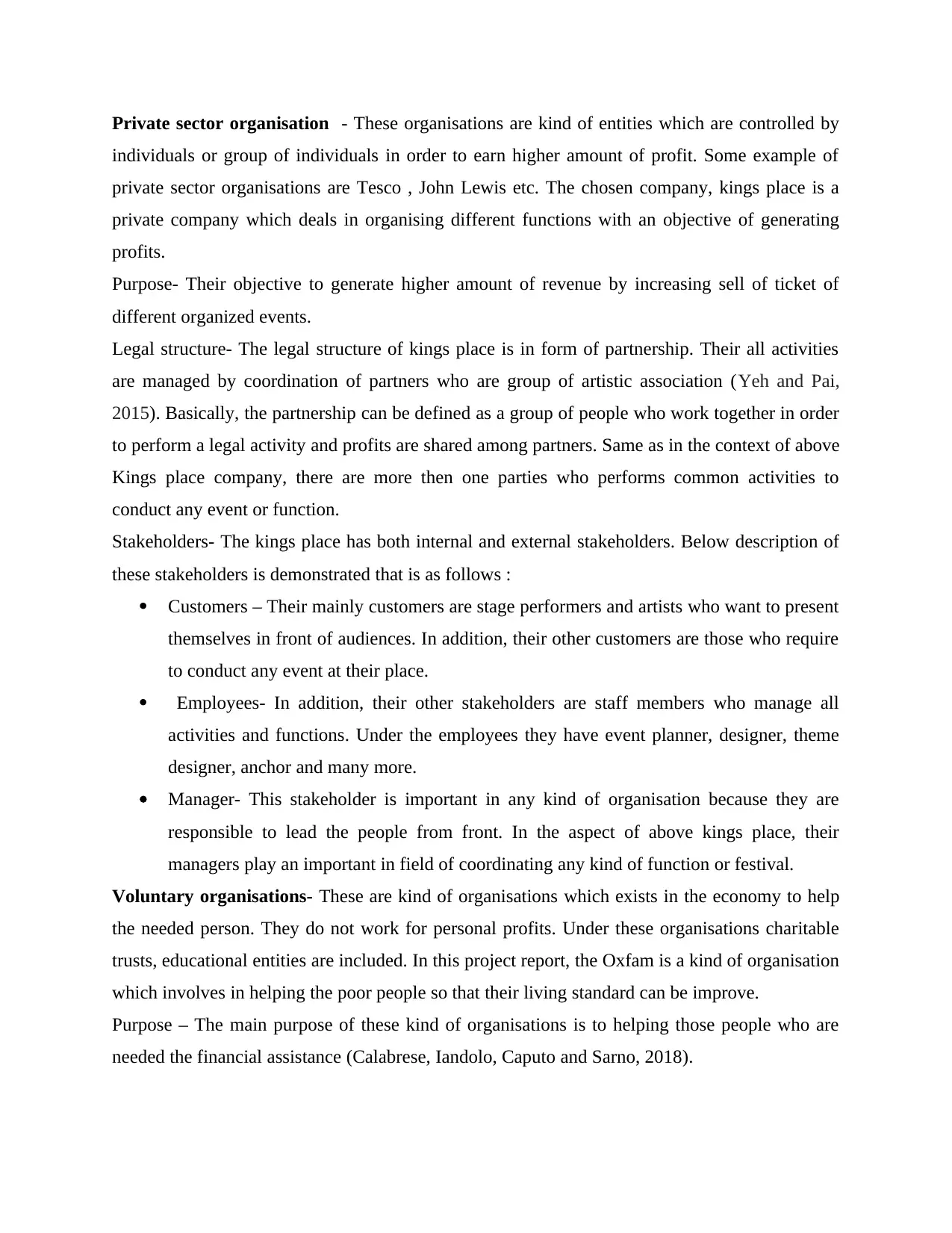
Private sector organisation - These organisations are kind of entities which are controlled by
individuals or group of individuals in order to earn higher amount of profit. Some example of
private sector organisations are Tesco , John Lewis etc. The chosen company, kings place is a
private company which deals in organising different functions with an objective of generating
profits.
Purpose- Their objective to generate higher amount of revenue by increasing sell of ticket of
different organized events.
Legal structure- The legal structure of kings place is in form of partnership. Their all activities
are managed by coordination of partners who are group of artistic association (Yeh and Pai,
2015). Basically, the partnership can be defined as a group of people who work together in order
to perform a legal activity and profits are shared among partners. Same as in the context of above
Kings place company, there are more then one parties who performs common activities to
conduct any event or function.
Stakeholders- The kings place has both internal and external stakeholders. Below description of
these stakeholders is demonstrated that is as follows :
Customers – Their mainly customers are stage performers and artists who want to present
themselves in front of audiences. In addition, their other customers are those who require
to conduct any event at their place.
Employees- In addition, their other stakeholders are staff members who manage all
activities and functions. Under the employees they have event planner, designer, theme
designer, anchor and many more.
Manager- This stakeholder is important in any kind of organisation because they are
responsible to lead the people from front. In the aspect of above kings place, their
managers play an important in field of coordinating any kind of function or festival.
Voluntary organisations- These are kind of organisations which exists in the economy to help
the needed person. They do not work for personal profits. Under these organisations charitable
trusts, educational entities are included. In this project report, the Oxfam is a kind of organisation
which involves in helping the poor people so that their living standard can be improve.
Purpose – The main purpose of these kind of organisations is to helping those people who are
needed the financial assistance (Calabrese, Iandolo, Caputo and Sarno, 2018).
individuals or group of individuals in order to earn higher amount of profit. Some example of
private sector organisations are Tesco , John Lewis etc. The chosen company, kings place is a
private company which deals in organising different functions with an objective of generating
profits.
Purpose- Their objective to generate higher amount of revenue by increasing sell of ticket of
different organized events.
Legal structure- The legal structure of kings place is in form of partnership. Their all activities
are managed by coordination of partners who are group of artistic association (Yeh and Pai,
2015). Basically, the partnership can be defined as a group of people who work together in order
to perform a legal activity and profits are shared among partners. Same as in the context of above
Kings place company, there are more then one parties who performs common activities to
conduct any event or function.
Stakeholders- The kings place has both internal and external stakeholders. Below description of
these stakeholders is demonstrated that is as follows :
Customers – Their mainly customers are stage performers and artists who want to present
themselves in front of audiences. In addition, their other customers are those who require
to conduct any event at their place.
Employees- In addition, their other stakeholders are staff members who manage all
activities and functions. Under the employees they have event planner, designer, theme
designer, anchor and many more.
Manager- This stakeholder is important in any kind of organisation because they are
responsible to lead the people from front. In the aspect of above kings place, their
managers play an important in field of coordinating any kind of function or festival.
Voluntary organisations- These are kind of organisations which exists in the economy to help
the needed person. They do not work for personal profits. Under these organisations charitable
trusts, educational entities are included. In this project report, the Oxfam is a kind of organisation
which involves in helping the poor people so that their living standard can be improve.
Purpose – The main purpose of these kind of organisations is to helping those people who are
needed the financial assistance (Calabrese, Iandolo, Caputo and Sarno, 2018).
Paraphrase This Document
Need a fresh take? Get an instant paraphrase of this document with our AI Paraphraser
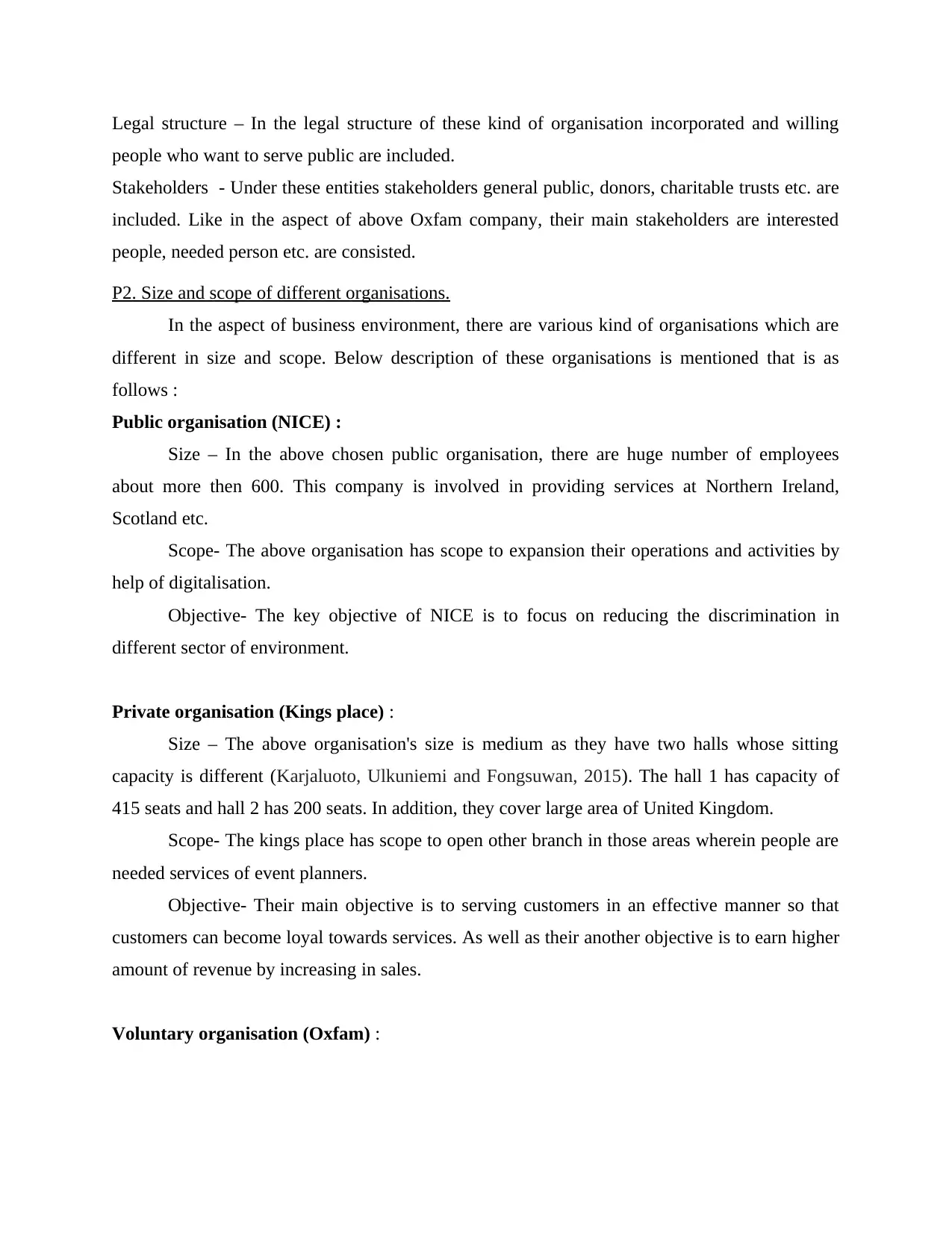
Legal structure – In the legal structure of these kind of organisation incorporated and willing
people who want to serve public are included.
Stakeholders - Under these entities stakeholders general public, donors, charitable trusts etc. are
included. Like in the aspect of above Oxfam company, their main stakeholders are interested
people, needed person etc. are consisted.
P2. Size and scope of different organisations.
In the aspect of business environment, there are various kind of organisations which are
different in size and scope. Below description of these organisations is mentioned that is as
follows :
Public organisation (NICE) :
Size – In the above chosen public organisation, there are huge number of employees
about more then 600. This company is involved in providing services at Northern Ireland,
Scotland etc.
Scope- The above organisation has scope to expansion their operations and activities by
help of digitalisation.
Objective- The key objective of NICE is to focus on reducing the discrimination in
different sector of environment.
Private organisation (Kings place) :
Size – The above organisation's size is medium as they have two halls whose sitting
capacity is different (Karjaluoto, Ulkuniemi and Fongsuwan, 2015). The hall 1 has capacity of
415 seats and hall 2 has 200 seats. In addition, they cover large area of United Kingdom.
Scope- The kings place has scope to open other branch in those areas wherein people are
needed services of event planners.
Objective- Their main objective is to serving customers in an effective manner so that
customers can become loyal towards services. As well as their another objective is to earn higher
amount of revenue by increasing in sales.
Voluntary organisation (Oxfam) :
people who want to serve public are included.
Stakeholders - Under these entities stakeholders general public, donors, charitable trusts etc. are
included. Like in the aspect of above Oxfam company, their main stakeholders are interested
people, needed person etc. are consisted.
P2. Size and scope of different organisations.
In the aspect of business environment, there are various kind of organisations which are
different in size and scope. Below description of these organisations is mentioned that is as
follows :
Public organisation (NICE) :
Size – In the above chosen public organisation, there are huge number of employees
about more then 600. This company is involved in providing services at Northern Ireland,
Scotland etc.
Scope- The above organisation has scope to expansion their operations and activities by
help of digitalisation.
Objective- The key objective of NICE is to focus on reducing the discrimination in
different sector of environment.
Private organisation (Kings place) :
Size – The above organisation's size is medium as they have two halls whose sitting
capacity is different (Karjaluoto, Ulkuniemi and Fongsuwan, 2015). The hall 1 has capacity of
415 seats and hall 2 has 200 seats. In addition, they cover large area of United Kingdom.
Scope- The kings place has scope to open other branch in those areas wherein people are
needed services of event planners.
Objective- Their main objective is to serving customers in an effective manner so that
customers can become loyal towards services. As well as their another objective is to earn higher
amount of revenue by increasing in sales.
Voluntary organisation (Oxfam) :
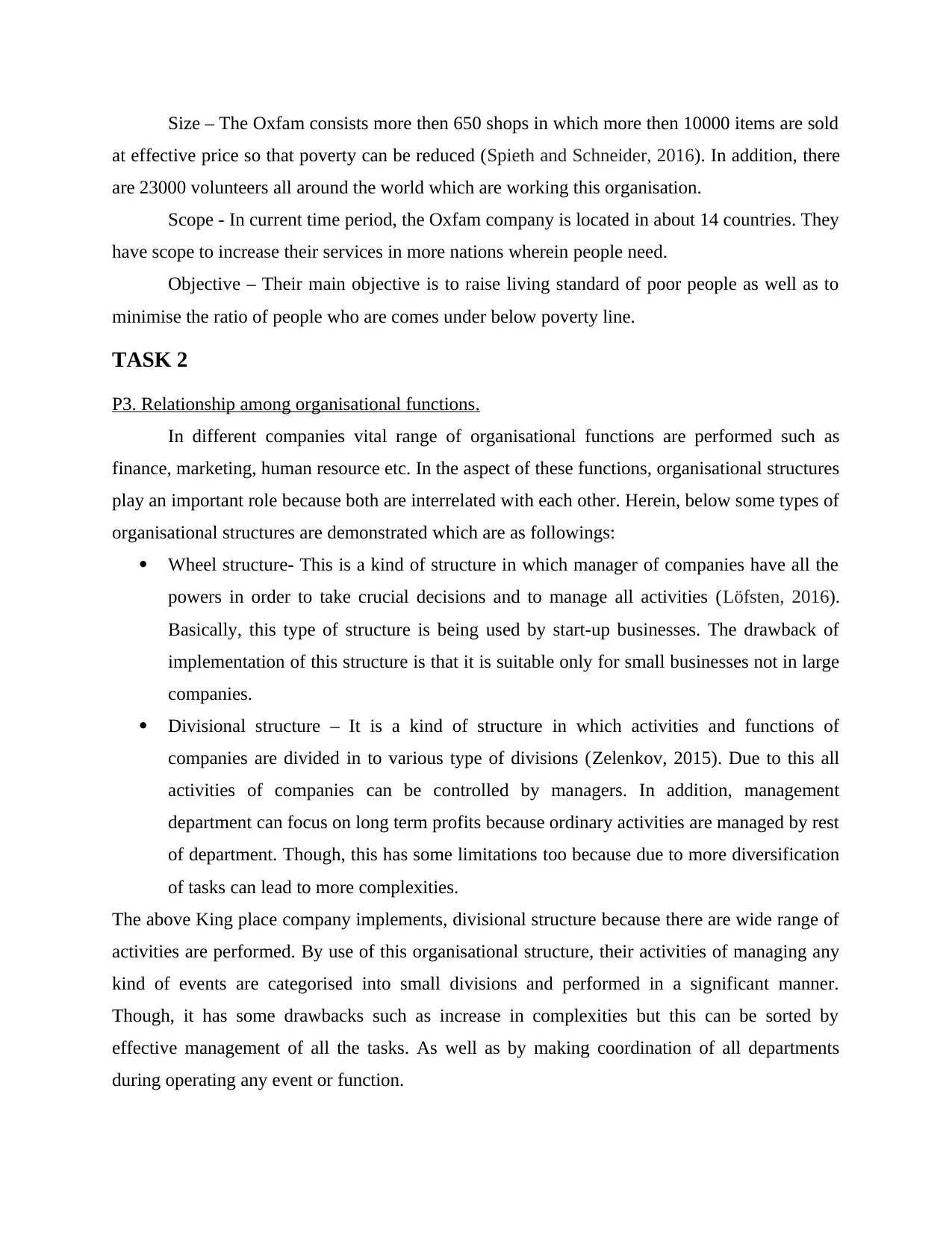
Size – The Oxfam consists more then 650 shops in which more then 10000 items are sold
at effective price so that poverty can be reduced (Spieth and Schneider, 2016). In addition, there
are 23000 volunteers all around the world which are working this organisation.
Scope - In current time period, the Oxfam company is located in about 14 countries. They
have scope to increase their services in more nations wherein people need.
Objective – Their main objective is to raise living standard of poor people as well as to
minimise the ratio of people who are comes under below poverty line.
TASK 2
P3. Relationship among organisational functions.
In different companies vital range of organisational functions are performed such as
finance, marketing, human resource etc. In the aspect of these functions, organisational structures
play an important role because both are interrelated with each other. Herein, below some types of
organisational structures are demonstrated which are as followings:
Wheel structure- This is a kind of structure in which manager of companies have all the
powers in order to take crucial decisions and to manage all activities (Löfsten, 2016).
Basically, this type of structure is being used by start-up businesses. The drawback of
implementation of this structure is that it is suitable only for small businesses not in large
companies.
Divisional structure – It is a kind of structure in which activities and functions of
companies are divided in to various type of divisions (Zelenkov, 2015). Due to this all
activities of companies can be controlled by managers. In addition, management
department can focus on long term profits because ordinary activities are managed by rest
of department. Though, this has some limitations too because due to more diversification
of tasks can lead to more complexities.
The above King place company implements, divisional structure because there are wide range of
activities are performed. By use of this organisational structure, their activities of managing any
kind of events are categorised into small divisions and performed in a significant manner.
Though, it has some drawbacks such as increase in complexities but this can be sorted by
effective management of all the tasks. As well as by making coordination of all departments
during operating any event or function.
at effective price so that poverty can be reduced (Spieth and Schneider, 2016). In addition, there
are 23000 volunteers all around the world which are working this organisation.
Scope - In current time period, the Oxfam company is located in about 14 countries. They
have scope to increase their services in more nations wherein people need.
Objective – Their main objective is to raise living standard of poor people as well as to
minimise the ratio of people who are comes under below poverty line.
TASK 2
P3. Relationship among organisational functions.
In different companies vital range of organisational functions are performed such as
finance, marketing, human resource etc. In the aspect of these functions, organisational structures
play an important role because both are interrelated with each other. Herein, below some types of
organisational structures are demonstrated which are as followings:
Wheel structure- This is a kind of structure in which manager of companies have all the
powers in order to take crucial decisions and to manage all activities (Löfsten, 2016).
Basically, this type of structure is being used by start-up businesses. The drawback of
implementation of this structure is that it is suitable only for small businesses not in large
companies.
Divisional structure – It is a kind of structure in which activities and functions of
companies are divided in to various type of divisions (Zelenkov, 2015). Due to this all
activities of companies can be controlled by managers. In addition, management
department can focus on long term profits because ordinary activities are managed by rest
of department. Though, this has some limitations too because due to more diversification
of tasks can lead to more complexities.
The above King place company implements, divisional structure because there are wide range of
activities are performed. By use of this organisational structure, their activities of managing any
kind of events are categorised into small divisions and performed in a significant manner.
Though, it has some drawbacks such as increase in complexities but this can be sorted by
effective management of all the tasks. As well as by making coordination of all departments
during operating any event or function.
⊘ This is a preview!⊘
Do you want full access?
Subscribe today to unlock all pages.

Trusted by 1+ million students worldwide
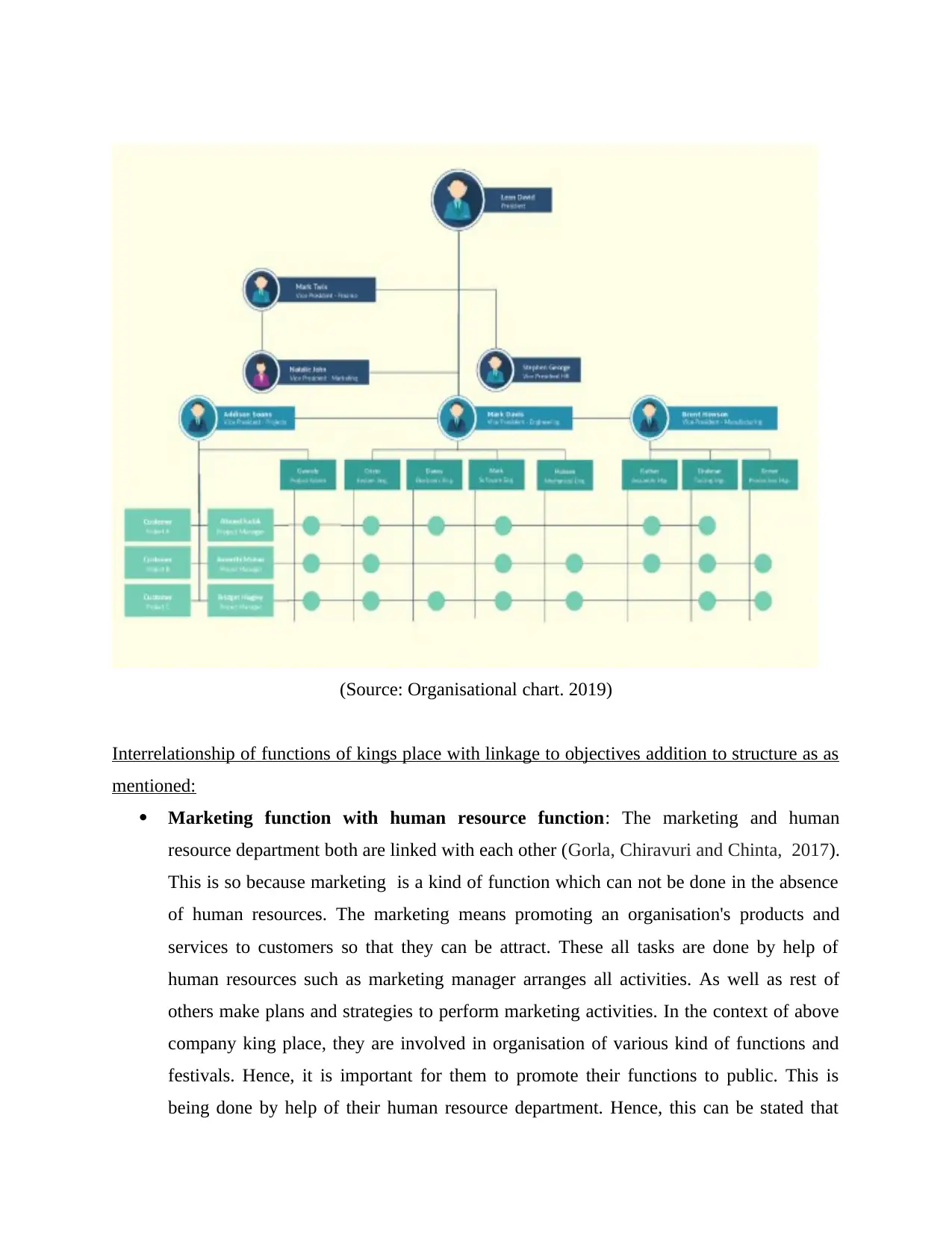
(Source: Organisational chart. 2019)
Interrelationship of functions of kings place with linkage to objectives addition to structure as as
mentioned:
Marketing function with human resource function: The marketing and human
resource department both are linked with each other (Gorla, Chiravuri and Chinta, 2017).
This is so because marketing is a kind of function which can not be done in the absence
of human resources. The marketing means promoting an organisation's products and
services to customers so that they can be attract. These all tasks are done by help of
human resources such as marketing manager arranges all activities. As well as rest of
others make plans and strategies to perform marketing activities. In the context of above
company king place, they are involved in organisation of various kind of functions and
festivals. Hence, it is important for them to promote their functions to public. This is
being done by help of their human resource department. Hence, this can be stated that
Interrelationship of functions of kings place with linkage to objectives addition to structure as as
mentioned:
Marketing function with human resource function: The marketing and human
resource department both are linked with each other (Gorla, Chiravuri and Chinta, 2017).
This is so because marketing is a kind of function which can not be done in the absence
of human resources. The marketing means promoting an organisation's products and
services to customers so that they can be attract. These all tasks are done by help of
human resources such as marketing manager arranges all activities. As well as rest of
others make plans and strategies to perform marketing activities. In the context of above
company king place, they are involved in organisation of various kind of functions and
festivals. Hence, it is important for them to promote their functions to public. This is
being done by help of their human resource department. Hence, this can be stated that
Paraphrase This Document
Need a fresh take? Get an instant paraphrase of this document with our AI Paraphraser
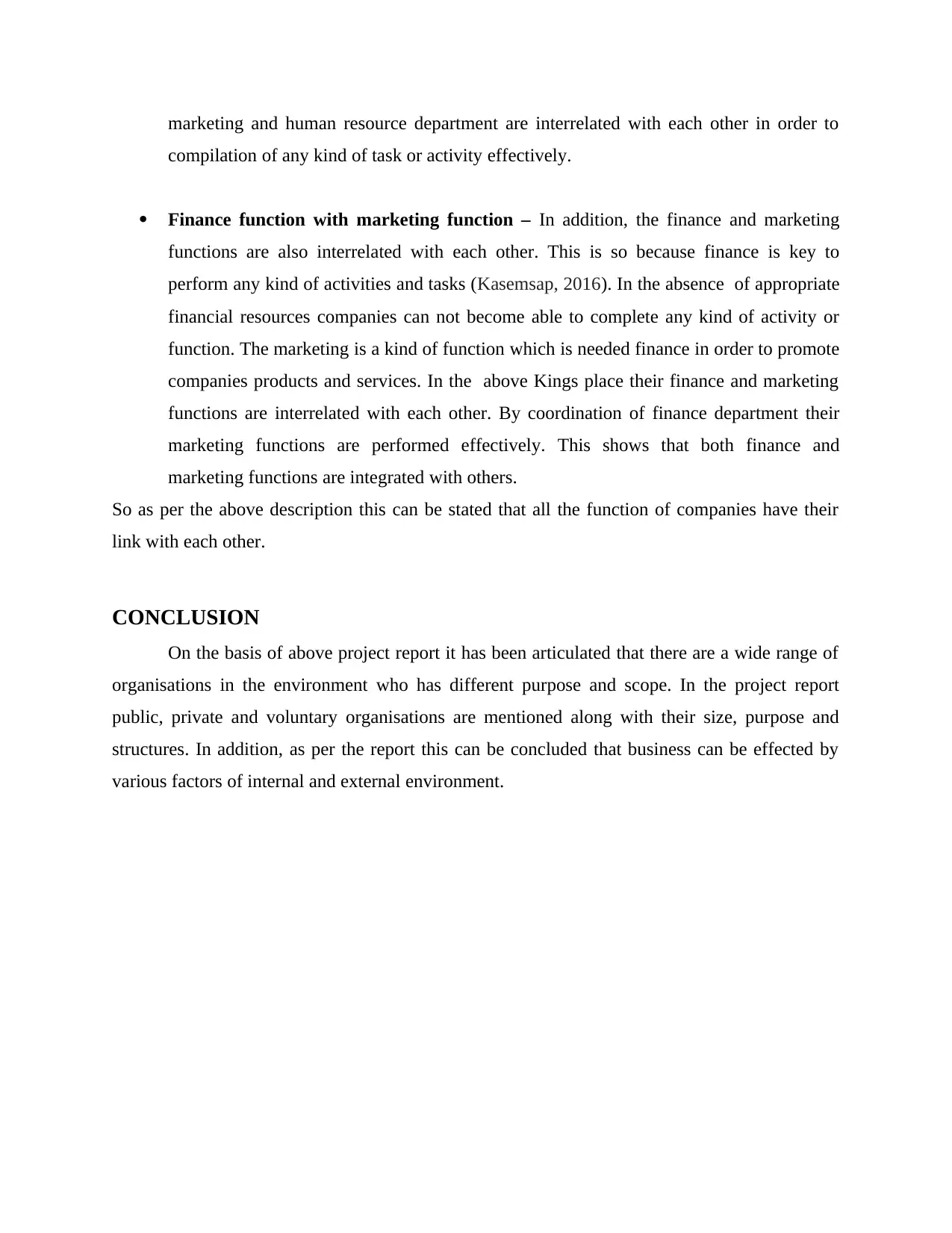
marketing and human resource department are interrelated with each other in order to
compilation of any kind of task or activity effectively.
Finance function with marketing function – In addition, the finance and marketing
functions are also interrelated with each other. This is so because finance is key to
perform any kind of activities and tasks (Kasemsap, 2016). In the absence of appropriate
financial resources companies can not become able to complete any kind of activity or
function. The marketing is a kind of function which is needed finance in order to promote
companies products and services. In the above Kings place their finance and marketing
functions are interrelated with each other. By coordination of finance department their
marketing functions are performed effectively. This shows that both finance and
marketing functions are integrated with others.
So as per the above description this can be stated that all the function of companies have their
link with each other.
CONCLUSION
On the basis of above project report it has been articulated that there are a wide range of
organisations in the environment who has different purpose and scope. In the project report
public, private and voluntary organisations are mentioned along with their size, purpose and
structures. In addition, as per the report this can be concluded that business can be effected by
various factors of internal and external environment.
compilation of any kind of task or activity effectively.
Finance function with marketing function – In addition, the finance and marketing
functions are also interrelated with each other. This is so because finance is key to
perform any kind of activities and tasks (Kasemsap, 2016). In the absence of appropriate
financial resources companies can not become able to complete any kind of activity or
function. The marketing is a kind of function which is needed finance in order to promote
companies products and services. In the above Kings place their finance and marketing
functions are interrelated with each other. By coordination of finance department their
marketing functions are performed effectively. This shows that both finance and
marketing functions are integrated with others.
So as per the above description this can be stated that all the function of companies have their
link with each other.
CONCLUSION
On the basis of above project report it has been articulated that there are a wide range of
organisations in the environment who has different purpose and scope. In the project report
public, private and voluntary organisations are mentioned along with their size, purpose and
structures. In addition, as per the report this can be concluded that business can be effected by
various factors of internal and external environment.
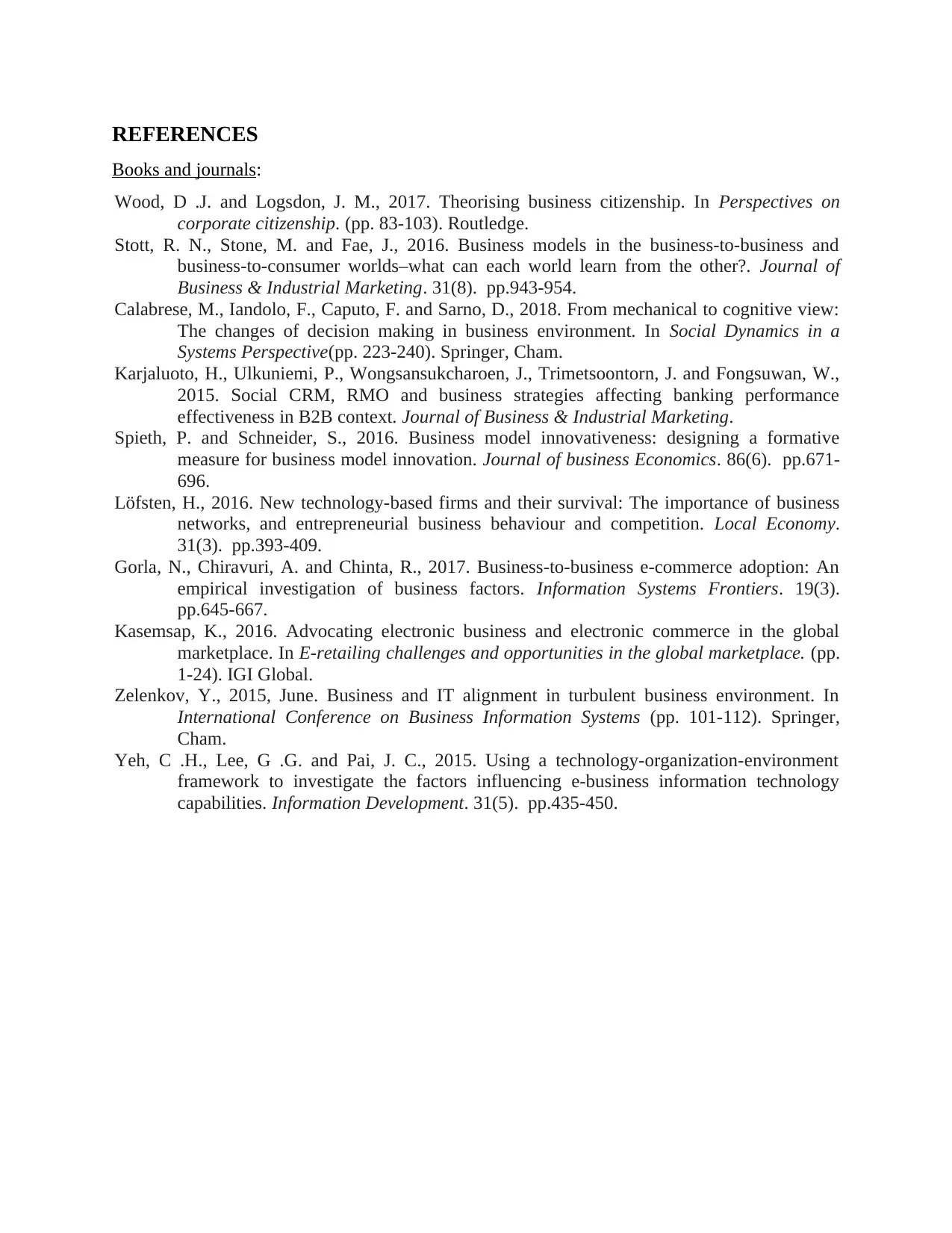
REFERENCES
Books and journals:
Wood, D .J. and Logsdon, J. M., 2017. Theorising business citizenship. In Perspectives on
corporate citizenship. (pp. 83-103). Routledge.
Stott, R. N., Stone, M. and Fae, J., 2016. Business models in the business-to-business and
business-to-consumer worlds–what can each world learn from the other?. Journal of
Business & Industrial Marketing. 31(8). pp.943-954.
Calabrese, M., Iandolo, F., Caputo, F. and Sarno, D., 2018. From mechanical to cognitive view:
The changes of decision making in business environment. In Social Dynamics in a
Systems Perspective(pp. 223-240). Springer, Cham.
Karjaluoto, H., Ulkuniemi, P., Wongsansukcharoen, J., Trimetsoontorn, J. and Fongsuwan, W.,
2015. Social CRM, RMO and business strategies affecting banking performance
effectiveness in B2B context. Journal of Business & Industrial Marketing.
Spieth, P. and Schneider, S., 2016. Business model innovativeness: designing a formative
measure for business model innovation. Journal of business Economics. 86(6). pp.671-
696.
Löfsten, H., 2016. New technology-based firms and their survival: The importance of business
networks, and entrepreneurial business behaviour and competition. Local Economy.
31(3). pp.393-409.
Gorla, N., Chiravuri, A. and Chinta, R., 2017. Business-to-business e-commerce adoption: An
empirical investigation of business factors. Information Systems Frontiers. 19(3).
pp.645-667.
Kasemsap, K., 2016. Advocating electronic business and electronic commerce in the global
marketplace. In E-retailing challenges and opportunities in the global marketplace. (pp.
1-24). IGI Global.
Zelenkov, Y., 2015, June. Business and IT alignment in turbulent business environment. In
International Conference on Business Information Systems (pp. 101-112). Springer,
Cham.
Yeh, C .H., Lee, G .G. and Pai, J. C., 2015. Using a technology-organization-environment
framework to investigate the factors influencing e-business information technology
capabilities. Information Development. 31(5). pp.435-450.
Books and journals:
Wood, D .J. and Logsdon, J. M., 2017. Theorising business citizenship. In Perspectives on
corporate citizenship. (pp. 83-103). Routledge.
Stott, R. N., Stone, M. and Fae, J., 2016. Business models in the business-to-business and
business-to-consumer worlds–what can each world learn from the other?. Journal of
Business & Industrial Marketing. 31(8). pp.943-954.
Calabrese, M., Iandolo, F., Caputo, F. and Sarno, D., 2018. From mechanical to cognitive view:
The changes of decision making in business environment. In Social Dynamics in a
Systems Perspective(pp. 223-240). Springer, Cham.
Karjaluoto, H., Ulkuniemi, P., Wongsansukcharoen, J., Trimetsoontorn, J. and Fongsuwan, W.,
2015. Social CRM, RMO and business strategies affecting banking performance
effectiveness in B2B context. Journal of Business & Industrial Marketing.
Spieth, P. and Schneider, S., 2016. Business model innovativeness: designing a formative
measure for business model innovation. Journal of business Economics. 86(6). pp.671-
696.
Löfsten, H., 2016. New technology-based firms and their survival: The importance of business
networks, and entrepreneurial business behaviour and competition. Local Economy.
31(3). pp.393-409.
Gorla, N., Chiravuri, A. and Chinta, R., 2017. Business-to-business e-commerce adoption: An
empirical investigation of business factors. Information Systems Frontiers. 19(3).
pp.645-667.
Kasemsap, K., 2016. Advocating electronic business and electronic commerce in the global
marketplace. In E-retailing challenges and opportunities in the global marketplace. (pp.
1-24). IGI Global.
Zelenkov, Y., 2015, June. Business and IT alignment in turbulent business environment. In
International Conference on Business Information Systems (pp. 101-112). Springer,
Cham.
Yeh, C .H., Lee, G .G. and Pai, J. C., 2015. Using a technology-organization-environment
framework to investigate the factors influencing e-business information technology
capabilities. Information Development. 31(5). pp.435-450.
⊘ This is a preview!⊘
Do you want full access?
Subscribe today to unlock all pages.

Trusted by 1+ million students worldwide
1 out of 9
Related Documents
Your All-in-One AI-Powered Toolkit for Academic Success.
+13062052269
info@desklib.com
Available 24*7 on WhatsApp / Email
![[object Object]](/_next/static/media/star-bottom.7253800d.svg)
Unlock your academic potential
Copyright © 2020–2025 A2Z Services. All Rights Reserved. Developed and managed by ZUCOL.




